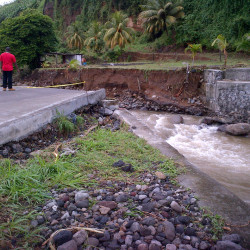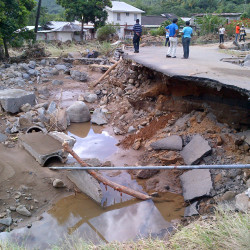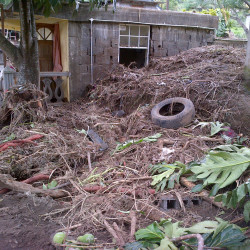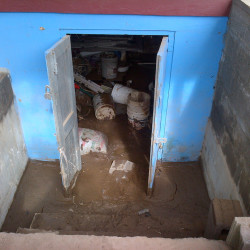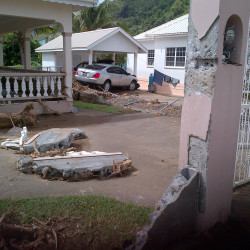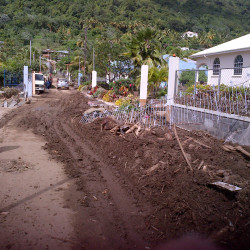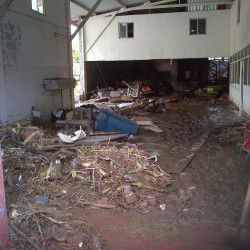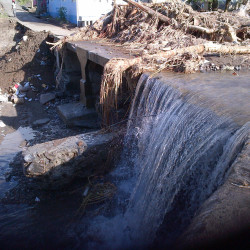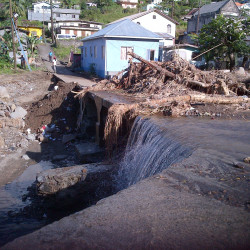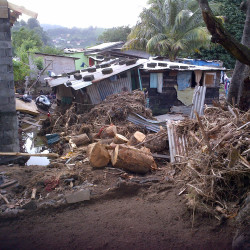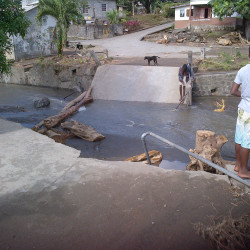COMMUNITY CAPACITY: Enabling Local Leaders
Saint Vincent and the Grenadines (SVG) is extremely vulnerable to the impacts of climate change. As a Small Island Developing State the impacts of rising sea levels, increased storm intensity, prolonged drought, and the spread of new diseases have compounding effects on the economic, social, and environmental systems of this multi-island state. However, communities across the islands are stepping up to find solutions to these challenges by building their capacity to deal with the uncertainties of a changing climate.
Climate Impacts




Sectors & strategies









CHAPTER 1: Getting to know Saint Vincent and the Grenadines
Explore how three communities across the country are building resilience in the face of a changing climate.
Start on the mainland of St. Vincent to learn about efforts to ensure water security during times of emergency and how one person’s idea can help spur an island-wide effort to build community resilience.
Then, travel to Bequia (pronounced beck-way), the second largest Grenadine Island, to learn how infrastructure investments are improving access to clean drinking water and reducing greenhouse gas emissions.
Finally, land on Union Island, where you’ll hear from community leaders working to build community resilience through an integrated economic empowerment model, one that couples environmental conservation with economic opportunity and education.
Geographic and Economic Context
The island chain of St. Vincent and the Grenadines was formed by a string of volcanoes that line the convergence of the Atlantic and Caribbean tectonic plates. One of the most visible volcanoes in the region is La Soufriere on the north side of the mainland. It occupies close to one third of the island’s 150 square miles, and at 4,000 feet the active volcano towers over the dramatic mountainous landscape. Dense tropical rainforest covers the island’s steep slopes and are fed by an annual average of 150 inches of rain, and an average of 80 inches of rainfall on the coastal areas. The smaller Grenadine islands are distinctly different in terrain and environment, becoming flatter and more arid further south.
The 31 Grenadine islands, along with the mainland, were occupied by several colonial powers over the last 400 years including France, Spain and most recently Britain. In 1979 St. Vincent and the Grenadines became the last of the Windward Islands in the Eastern Caribbean to gain full independence and with a Parliamentary Democracy is still a member of the Commonwealth of Nations.
As of 2014 the population of St. Vincent and the Grenadines was just over 109,000 with 91 percent of the population living on the mainland. While the public sector is one of the largest employers on the mainland, many people are involved in farming as a source of livelihood, both through domestic and international markets. In contrast, the Grenadine islands are heavily dependent on international tourism, with much of the economy based in service industries. The more arid climate of the Grenadine Islands does not support the level of agricultural production seen on the mainland, with its rich volcanic soils and higher rainfall levels.
CHAPTER 2: Recovering from the flood, mainland St. Vincent
CLIMATE IMPACT: Extreme Storms and Flooding
St. Vincent and the Grenadines is extremely vulnerable to the impacts of climate change, which includes:
- Sea level rise leading to coastal erosion, loss of beaches, loss of agricultural land and saltwater intrusion
- Increased frequency and intensity of tropical storms and hurricanes; increased intensity of rain creates significant vulnerabilities from landslides given the steep topography
- Increased occurrence of floods and droughts leading to disruptions to freshwater supplies
- Ocean acidification, coral bleaching and loss of valuable reef ecosystem services
- Hotter surface and water temperatures leading to increased vector-borne diseases
- Multiple compounding economic effects to key industries such as tourism and agriculture
In 2006, the World Bank ranked St. Vincent and the Grenadines the second most disaster prone country in terms of land area and fifth in terms of population. As changes in our climate increase the intensity of tropical storms and hurricanes, St. Vincent and the Grenadines is increasingly susceptible to instability on the island’s mountainous terrain. This instability is exacerbated by changes in development and agricultural practices, resulting in landslides and erosion, which have numerous impacts on the island’s economic, environmental and social systems.
Central to these impacts is the issue of water scarcity and quality – leading the national government to identify improving the resilience of the water sector as a top climate change adaptation priority throughout the country.
Over the last few years St. Vincent and the Grenadines has experienced a number of extreme weather events, and while no single event can be solely attributed to our changing climate, they represent the type of extreme storms that are anticipated to occur more frequently throughout the Caribbean as our climate warms.
Hurricane Tomas, October 2010
On October 30–31, St Vincent and the Grenadines was hit by Hurricane Tomas, resulting in damages estimated at about 5 percent of GDP. Damages included:
- Roughly 26 percent of the population on the mainland was severely impacted
- Significant damage to main roads, schools, community centers and emergency shelters leaving many people isolated long after the hurricane
- 1,200 people were displaced and forced into hurricane shelters
Spring Flood, April 2011
Torrential rains over the Eastern Caribbean on the morning of April 12, 2011 brought the second natural disaster to St. Vincent and the Grenadines within six months. The strong rains caused:
- Disruptions to water supplies
- Large landslides causing extensive damage to the country’s infrastructure including highways, bridges, buildings, homes and schools
- Damages equivalent to 3.6 percent of GDP, although this figure is estimated to be low since it does not factor in long-term impacts to agriculture and tourism
- Heavy rains came at a time when reconstruction from Hurricane Tomas was underway, leaving many projects and investments derailed
More recently, on December 24, 2013, as families prepared for the Christmas Holiday-friends and families gathering to celebrate with food, drink, and festivities-an unexpected storm broke out across the mainland.
What is now referred to as the Christmas Eve Flood devastated the mainland with massive landslides and flooding, causing large-scale destruction to roads, buildings, and bridges. Within a matter of hours 12 people died and $108.3 million worth of damages, equivalent to 15 percent of the country’s GDP, had been inflicted. All hydroelectric facilities were forced offline, which left some without power until mid-2014.
LOCAL ACTION: backup water systems
During times of extreme storm events, heavy rainfall causes landslides on the mainland’s steep slopes. These flood-induced landslides can heavily damage the island’s water distribution systems, resulting in disruptions in water supplies, sometimes for months following extreme storm events (like the Christmas Eve Flood). Without access to clean drinking and sanitation water, residents face increased vulnerability to waterborne diseases and other compounding economic and health stresses.
However, government and community organizations, aware of the vulnerability of the island’s water system, are finding ways to increase resilience through international and cross-sector partnerships and are funding investments in backup and supplementary water storage systems.
In 2011 a regional climate change adaptation strategy was launched in the Caribbean. The strategy, Reduce Risks to Human and Natural Assets Resulting from Climate Change (RRACC), is administered through the Organization of Eastern Caribbean States’ (OECS) with funding from United States Agency for International Development (USAID). Through this partnership, a series of locally-selected climate change adaptation projects were implemented in six member states (Antigua and Barbuda, Dominica, Grenada, St Kitts and Nevis, Saint Lucia, and St Vincent and the Grenadines). While not a direct response to the Christmas Eve Flood, this broader effort will help increase water-sector resilience to extreme events by building a series of rainwater harvesting systems at six public buildings, including five emergency shelters and a juvenile reform center for boys, on the Mainland of St. Vincent.
This rainwater harvesting pilot project, while made possible by a complex network of national and international partners, originated from the hard work of a committed community member, Sharika Mandeville.
A Positive Change
How personal commitment can lead to tangible outcomes, Sharika Mandeville
The mainland RRACC projects provide emergency shelters with clean sanitation water during times of emergency and public service interruptions caused by extreme storm events. The projects also support agricultural programmes at schools and community centers and provide backup water systems to schools, allowing for fewer disruptions to school learning days, even during non-disaster related water system disruptions.
Explore the map to learn more about each of these locations
Rainwater harvesting provides the residents of St. Vincent with the assurance that the most basic need of freshwater will be met in a times of emergency and in a continuously changing environment. While the rainwater catchment projects are not technically unique, and in fact used to be common practice on the island before national water distribution networks were installed, they are an example of how looking back to traditional systems can help increase community resilience and lead to tangible community benefits.
CHAPTER 3: Living with drought, Bequia
Providing water to the residents of drought-prone Bequia (pronounced beck-way) is of growing importance given the increased frequency of drought-induced water shortages on the island.
Explore how the pilot desalination plant in Paget Farm, Bequia is improving the quantity and quality of local water supplies. Herman Miller, Deputy Director of Grenadines Affairs and long-time community activist and leader, explains why the desalination plant is such a critical infrastructure investment for both the community of Paget Farm, and the island in general.
Bequia is the second largest of the Grenadine islands measuring seven square miles. The island’s hilly landscape is covered with dense vegetation and remnants of former plantations. The many inlets and lagoons make it a popular destination among yachters looking to replenish provisions and visit the white sand beaches. Tourism makes up the largest part of the economy, supporting its nearly five thousand year-round residents.
The island does not have any surface water and very little groundwater, making it almost completely dependent on rainwater. The island’s dense vegetation is quick to show a lack of precipitation by changing from lush shades of green to a brittle brown during times of low rainfall.
CLIMATE IMPACT: Prolonged Drought
Bequia Island, like the mainland of Saint Vincent and the other Grenadine islands, faces several challenges from climate change. One of the most serious challenge comes from prolonged droughts, which leaves the island with limited access to freshwater.
Other climate change impacts include:
- Wave inundation, which leads to coastal erosion and drainage problems
- Saltwater intrusion from rising sea levels that contaminates sparse ground water along with low lying agricultural lands
- Prolonged periods of drought
- Increased frequency and intensity of tropical storms and hurricanes
- Ocean acidification, coral bleaching and loss of valuable reef ecosystem services
- Hotter surface and water temperatures leading to increased vector-borne diseases
The impacts of drought on Bequia Island, Herman Belmar
The impacts of drought on Bequia Island, Herman Belmar
LOCAL ACTION: Desalination
Increasing water security in Paget Farm, Bequia, Herman Belmar
While desalination has been incorporated as a critical source of freshwater on the island, this technological adaptation has not gone without its challenges. In addition to the technological adaptation, the community of Paget Farm needed to overcome the perception that desalinated water was not suitable to drink. However, as droughts worsened on the island and people became more desperate for water this misconception quickly disappeared. In addition, there are a set of complicated behavior change challenges that arise from adaptation projects like the desalination plant in Bequia; as freshwater is more consistently available there is a risk that residents may abandon water-saving and conservation practices, thereby possibly reducing overall community resilience and creating a false sense of security. These behavior changes can set in place a type of path dependency that is hard to reverse.
The desalination project on Bequia has also led to some unanticipated behavior changes. For example, since the introduction of a photovoltaic system for the desalination plant in Paget Farm, the growth of solar energy demand grew more rapidly than anticipated. The local adoption of renewable energy grew so quickly that the electricity company capped the expansion of solar since demand outpaced the speed at which they could adapt their energy supply infrastructure.
Bequia’s RRACC project expands the storage facility for freshwater coming from the desalination plant from 20,000 to 60,000 gallons, and includes a local distribution system to Paget Farm, a highly vulnerable community with very limited water access and supplies.
Desalination system specifications
- 60,000 gallons
Distribution | Two distribution points
- Paget Farm
- Desalination plant
Energy Supply | Renewable photovoltaic system
- Installation - 330 standard panels mounted on the hangar roof at the Bequia airport
- Nominal power - 70kW
- Rated output - 130,000 kWh/year
- Energy demand - 78,000 kWh/year
- Surplus energy is sold to the national utility, Vinlec, and transmitted to the island’s grid via six inverters located at the airport
- Revenue from net metering supports ongoing maintenance costs
Monitoring | Remote system
- PV system is monitored from a remote location and provides timely notifications in the case of generation disruptions
- Remote monitoring provides an additional layer of security for long-term monitoring and safeguards data in the case of an extreme event or storm
Given Bequia’s limited water resources and the high costs of obtaining fresh water on the drought prone island, the desalination plant provides a critical resources to local residents. For the community of Paget Farm, a low-income and climate vulnerable community, this resource provides relief to an already stressed population. It is estimated that up to 30 percent of housing construction cost is allocated to building a rain harvesting system, yet given the steep terrain of the Paget Farm area, many of these systems cannot be built large enough to sustain households during periods of prolonged drought. The desalination plant provides an alternative option to a situation that may otherwise require forced migration from the island for many residents.
CHAPTER 4 : Leading by Example, Union Island
Meet Katrina Collins, the founder of The Union Island Environmental Attackers, as she discusses the role her organization has played in community-based adaptation and capacity building on the island, as well as the critical importance of incorporating economic opportunity into environmental conservation.
Roseman Adams, a community leader and local business owner, highlights the important role the Attackers play in improving the health and wellbeing of people and the environment.
And finally, Orisha Joseph, Executive Director of Sustainable Grenadines (SusGren), highlights some of the challenges and opportunities of working on climate change on a small island.
Union Island lies at the southern tip of the multi-island state of St. Vincent and the Grenadines, about 40 miles south of the mainland. The island is three miles long and about one mile wide, and is home to approximately three thousand residents. Union Island depends on tourism as its main source of income and serves as an important anchorage location for passing yachts in the East Caribbean. The volcanic island is home to the tallest peak in the grenadines, but does not reach a height sufficient to capture moisture or increase rainfall, as on the mainland. With little surface water or groundwater the island is reliant on rainwater catchment systems to supply enough fresh water for drier months.
CLIMATE IMPACT: Prolonged Drought
Union Island, like other islands throughout the Caribbean, faces many impacts from climate change, including:
- Wave inundation, which leads to coastal erosion and drainage problems
- Saltwater intrusion from rising sea levels that contaminates sparse ground water, along with low-lying agricultural lands
- Prolonged periods of drought
- Increased frequency and intensity of tropical storms and hurricanes
- Ocean acidification, coral bleaching and loss of valuable reef ecosystem services
- Hotter surface and water temperatures leading to increased vector-borne diseases
LOCAL ACTION: Community Empowerment
A vibrant community’s approach to dealing with climate change: the Union Island Environmental Attackers
In 1999, a group of motivated community members joined together to start the Union Island Environmental Attackers. The catalyst for this community collaboration was an understanding of the importance the environment plays in the economic survival of Union Island. While a tourist destination, the residents of Union Island often feel removed from the decisions of the mainland so they have focused on building their local capacity to solve community issues. But, this doesn’t mean there isn’t a place for collaboration or partnerships – in fact, Union Island is home to a number of organizations that work across sectors and international boundaries.
Katrina CollinsKatrina Collins, founder of the Union Island Environmental Attackers, describes the origins of the organization
The first challenge the Attackers focused on was garbage. They started with a single clean up event but it didn’t stop there – this effort ultimately led to major improvements in island-wide garbage collection and waste management practices. “We have changed Union Island’s garbage collection and the way people do things here on the island, you know a whole lot. It’s much better than it was many years ago… we don’t have those open trucks where the garbage would be thrown in… and as the winds blow, the plastic bags go flying all over the place. We used to also burn the garbage, now we don’t do that anymore…” Instead, it’s put in “a landfill that is mixed with dirt. It’s treated and managed much better than before.”
The attackers have since moved on to other issues, including climate change and water security. While the Caribbean is expected to experience greater precipitation during storms, more frequent and longer droughts are expected to stress an already fragile water system. On an island with no surface water and extremely limited groundwater for nonpotable uses, the dynamic of more intense, but less frequent rain results in a dependence on rainwater harvesting for all drinking water. As described by Roseman, during times of drought, “persons who are not as privileged as others…” are “unable to have their own water catchment at their homes.” He continues, “So, if you can’t afford [your own tank] then you’d have to go to the government cisterns” to fill up water containers. While water from the government cisterns is free, the transport costs are not. And, because only a limited amount of water can be transported at a time, “…it means that you have to do it many times per week. And that can run up a serious bill. So you find those who are not so privileged, they have to spend a lot of their income on transportation of water to their homes.” This feedback loop means that as the climate changes, families face hard economic choices and limitations.
However, the Environmental Attackers “thought it wise”, as Roseman says, to address this water scarcity issue and distribute water tanks to vulnerable households across the island.
With funding of $200,000 ECD (East Caribbean Dollars) from the Canadian Government’s Caribbean Disaster Risk Management Fund (through the former Canadian International Development Agency) the group launched their project in September 2012. They held monthly training meetings and workshops with community members around issues of water sanitation and conservation and, in April 2014, one hundred 1,000-gallon tanks arrived on the island – increasing the island’s storage capacity by 100,000 gallons. The tanks were distributed to households who either had damaged and inadequate tanks or no water storage capacity.
While providing on-the-ground support to the community is critical, climate change awareness and capacity building is equally important on Union Island. Orisha Joseph, Executive Director of Sustainable Grenadines (SusGren), a local non-profit that primarily focuses on trans boundary marine and coastal conservation, recognizes that climate change is a relatively new issue for residents on the island. Through different participatory events and trainings SusGren and the Union Island Attackers are starting the conversation. “In talking about climate change, it’s something that is new and people are getting the hang of it. They know that something is happening in their environment and in the climate, although they don’t know what exactly… they realize they do have to act.” Organizations like SusGren and the Attackers are helping mobilize that action.
But this work takes a deep understanding of the community – a one-size fits all approach doesn’t work.
Katrina CollinsKatrina Collins, how to talk about climate change at a “grassroots” level
After a number of conversations, Katrina realized there was a need for more awareness programs, but rather than just holding public meetings at a “lone resource center…”, where you would only find a few people, she decided to meet people where they are. “…if you go where you find people ‘liming’ a lot on the blocks, and you go there, people will receive the message...” and you can get them to better understand.
Working on a small island presents a number of opportunities:
When asked why the Environmental Attackers have managed to be so successful, Roseman responded, “I think it’s because there is so much of a love within the group. We just love to do things for the island - we love the island, you know…. On a small island like this, it’s easier for us to work with one another. And, we all know the problems the island faces, and so it’s easy for us to agree on some of the problems that we have and to try and fix it… And of course, the funding that we receive, you know, that goes a whole long way.”
Orisha JosephOrisha Joseph, Sustainable Grenadines, describes community reaction to working on a participatory climate change project and explains some of the advantages of working on climate change on a small island
But there are also many challenges to doing this work on a small island:
Katrina explains that members of her organization work voluntarily, “none of us are being paid.” But she started to notice that as the cost of living continues to increase, fewer and fewer people are donating their time in volunteering because, according to Katrina, they “have families to mind, electricity bills to pay, [a] phone bill to pay, cable bill to pay.” The island does not produce the majority of its goods and services locally, which means most everything is imported from the mainland and other nearby islands, making to cost of even basic commodities increase. In addition, since Union Island’s economy is largely dependent on tourism, especially yachting, the community is dependent on a steady stream of visitors to support their economy – something that is not always guaranteed. With all these economic pressures affecting day-to-day life, climate change is not always at the top of people’s mind.
But, Roseman, Katrina, and the Attackers used this economic challenge as an opportunity to integrate their climate change and environmental awareness programs with livelihood creation. The Union Island Nature Adventure Tours is a cooperative that “came out of the Environmental Attackers because we recognize that… we need some source of income to keep us going… You know there must be some form of income so that people’s families can get by.” So the Attackers have organized bird watching trainings and tours, and with funding from the UN Global Environment Facility (GEF) Small Grants Programme, provided ten community members the opportunity to travel to Trinidad to become certified turtle handlers. Union Island is a home to a Leatherback Turtle nesting site and the training provided the local community an opportunity to “bridge the gap between public awareness, ownership, participation and sustainable livelihoods.
The energy to lead: collaboration as a source of motivation, Katrina Collins
While there is no shortage of work still to do, organizations like the Union Island Environmental Attackers and Sustainable Grenadines are working tirelessly to conserve the local environment, increase the resilience of Union Island to the impacts of climate change, and provide sustainable livelihood options. At the core of these efforts is a small group of residents who, through their love of place and commitment to their community, are investing in their future.
CHAPTER 5: Living with Climate Change
Lessons learned: dealing with the challenges of implementation
A common theme across each of the three locations in St. Vincent and the Grenadines is the need to build institutional and community capacity to ensure projects realize long-lasting success and communities have the ability to continue to adapt in the future. Building capacity requires a suite of strategies and tools - there is no single solution or approach - however, there are a number of common challenges and opportunities to be shared from the experiences of people working on the ground in St. Vincent and the Grenadines.
While climate change is a global phenomenon the impacts are always local and unique, which in turn requires response be tailored to local economic, social, and environmental contexts. However, communities often face many of the same implementation challenges and barriers, in spite of localized differences. For example, finding and securing funding for low-carbon technologies, supporting broad social and behavior changes, and developing and implementing a policy environment that enables climate adaptation are all common challenges to transitioning to a low-emissions and climate resilient world.
The following interactive tables provide insight into a number of implementation challenges and lessons learned from the projects and efforts across St. Vincent and the Grenadines.
Path dependency
Managing system changes
Access to low-cost technologies and materials
Funding system changes
Creating an enabling policy environment
Data collection and management
Public perception
Sharika MandevilleSharika Mandeville, Engineer, Ministry of Transport and Works
Nyasha HamiltonNyasha Hamilton, Environmental Management Unit, Ministry of Health and Environment
The development of new systems and technologies always comes with the risk of establishing new path dependencies. This is not a reason to forego development or the exploration of new technologies, however within the climate adaptation context, it is important to understand the impact that development has on induced demand and resource availability. Infrastructure development in Bequia highlights the relationship between social behavior and development.
Herman BelmarHerman Belmar, Deputy Director of Grenadine Affairs
Herman BelmarHerman Belmar, Deputy Director of Grenadine Affairs
Nyasha HamiltonNyasha Hamilton, Environmental Management Unit, Ministry of Health and Environment
Howie PrinceHowie Prince, Director, National Emergency Management Organisation
Howie PrinceHowie Prince, Director, National Emergency Management Organisation
Finding resources for physical adaptation efforts isn’t the only challenge to reducing vulnerability; increasing adaptive capacity by investing in people so as to strengthen their own ability to adapt and respond to the impacts of climate change is an issue the government of St. Vincent and the Grenadines is working to address.
Howie PrinceHowie Prince, Director, National Emergency Management Organisation
Given the critical role that non-governmental organizations (NGOs) play in implementing local climate actions, building community capacity is equally important to institutional capacity. While climate change is a global issue, the impacts are always local. However, without intentional investment in people, local organizations will not be equipped to respond to climate impacts. While this is a challenge in St. Vincent and the Grenadines, there are international, national and local efforts to strengthen NGOs across the country.
Nyasha HamiltonNyasha Hamilton, Environmental Management Unit, Ministry of Health and Environment
Hayden BillingyHayden Billingy, National Coordinator for the GEF Small Grant Programme at UNDP
Howie PrinceHowie Prince, Director, National Emergency Management Organisation
Nyasha HamiltonNyasha Hamilton, Environmental Management Unit, Ministry of Health and Environment
However, creating a centralized system for data collection and management is an important focus area in St. Vincent and the Grenadines. This includes ensuring that local and traditional knowledge is equally valued with scientific data.
Nyasha HamiltonNyasha Hamilton, Environmental Management Unit, Ministry of Health and Environment
Herman BelmarHerman Belmar, Deputy Director of Grenadine Affairs
Nyasha HamiltonNyasha Hamilton, Environmental Management Unit, Ministry of Health and Environment
Hayden BillingyHayden Billingy, National Coordinator for the GEF Small Grant Programme at UNDP
And, overcoming misperceptions about solution alternatives can be just as big a challenge as overcoming misconceptions about risk, sometimes resulting in a reactive adoption or uptake of solutions, once all other options are no longer available.
Hayden BillingyHayden Billingy, National Coordinator for the GEF Small Grant Programme at UNDP
Hayden BillingyHayden Billingy, National Coordinator for the GEF Small Grant Programme at UNDP
Sharika MandevilleSharika Mandeville, Engineer, Ministry of Transport and Works
Herman BelmarHerman Belmar, Deputy Director of Grenadine Affairs
Credits
Our Place On Earth
Our Place on Earth is a project of PrettyGoodProductions. PGPs' Mission is to creatively depict our beautiful and complex reality through film, art, and the written word.
info@prettygoodproductions.net
Collaborative management: Governance for the New Normal, Finland
Share this story
Post on Facebook
Tweet this
Share to Google+
Writer and concept design: Nuin-Tara Key
Co-author: Annierose Von Burg
Editorial advisor: Patrick Pringle
Video production and editor: Tom Miller, PrettyGoodProductions
Web developer: Lucas Balzer
Multimedia producers: Nuin-Tara Key, Tom Miller
December flood photos: Sharika Mandeville
Bequia drought photos: Herman Belmar
Bequia comparison photos: Jessica Jaja
Music: Tom Miller, PrettyGoodProductions
Partners

UK Climate Impacts Programme
The OPOE team would like to extend a special thanks to Nyasha Hamilton, Sharika Mandeville, Herman Belmar, Katrina Collins, Stanton Gomes and Mikell O’Mealy, your support and guidance made this experience possible.
Anonymous | Genevieve Anderson | Michele Anderson | Brianna Ayres | Richard Barrett | Thomas Beatty | Paul Benson | Rajiv Bhatia | Hilde Binford | Sondre Bjordal | Joan Blythe | Mark Bosnian | Danielle Boulé | Gordon Brown | Emily Brownlee | Elizabeth Burger | Rex Burkholder | Meghan Burnett | Alyssa Carlson | Molly Chidsey | Marion Christ | Alison Colwell | Caleb Cressman | Lindsey Cressman | Michele Crim | Bea Davis | J. Claire Dean | Tony DeFalco | Ali DeMersseman | Lee Dunne | Kim Ellis | Roger Espinoza | Carolyn Faszholz | Amanda Finke | Sharon Fujioka | Ted Fujioka | Kara Griffin | Caroline Haas | Corie Harlan | James Harrison | Matt Hayes | Brien Hemann | Melissa Herlitz | Jillian Hicks | Kyra Hill | Adam Hixon | Mike Hoglund | Kai Hsing | Juniper Hunter | Diane Husic | Ivan Interfeld | Gary Jacobs | JoEllen Jacobs | Amanda Johnson | Tom Johnson | Mike Jones | Maya Kamoshita | Ina Karish | Sheryl Kelsey | Melanie Ladygo | Elisa Lamont | Alyssa Latuchie | Karen Latuchie | Karin Laupheimer | Caroline Leary | Annie Lee | Lou Leonard | Jonas Lerman | Danielle Liu | Eli Madrone | Juliana Madrone | Sarah McCarty | Andrea McDowell | Chris Miller | Mark Miller | Paula Miller | Susie Miller | Ellen Millick | Elizabeth Milner | Adrian Mishek | Tacey Mishek | Katy Mistretta | Judy Mosher | Josh Naramore | Melanie Nead | Angie Noriega | Nigel Noriega | Libi O'Brien | Teresa O'Donnell | Mikell O'Mealy | Mary-Rain O'Meara | Alyssa Phelps | Bonnie Porter | Lizzy Prestel | Cheyenne Purrington | Cynthia Rancatore | Dan Rasay | Jon Ray | Christian Rebholz | Kalama Reuter | Beth Rodin | Natalia Ronceria Ceballos | Katie Rosinsky | Sayuri Sasaki Hemann | Ahn Scanlon | Ali Schneider | Lauren Schneider | Dean Scott | Dan Silk | Ellen Simmons | Oliver Smith | Carrie Snow | Kathryn Sofich | Laura Spidell | Cary Stacey | Erika Street | Nik Strong-Cvetich | Michael Sulis | Terra Tolley | Rory Turner | Daniel Vance | Annie Von Burg | Benjamin Waddell | Jason Ward | Ann Weinstein | David Weinstein | Aubrey White | Jodi White | Ken White | Chris Williams | Martin Wilson | Steve Zavetoski






